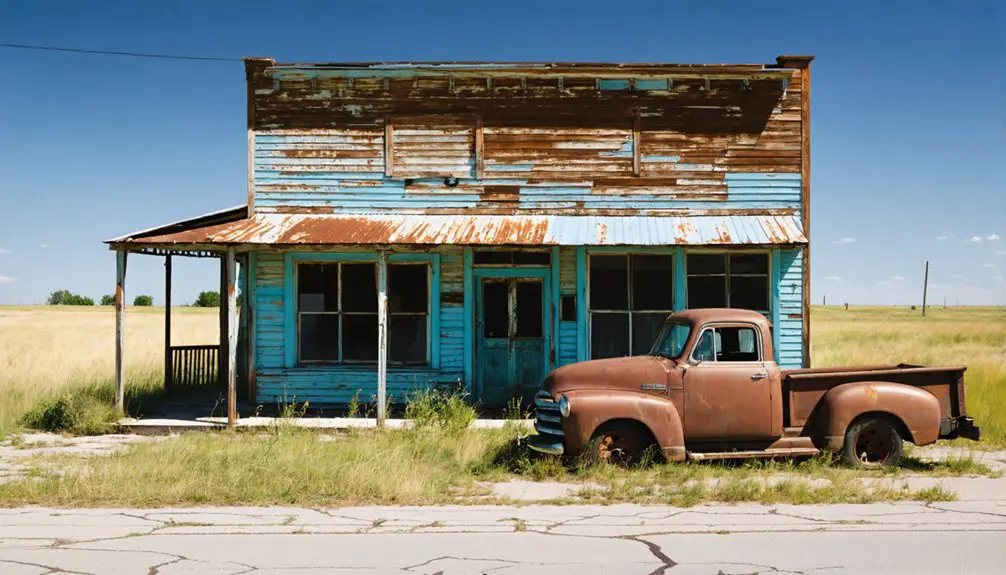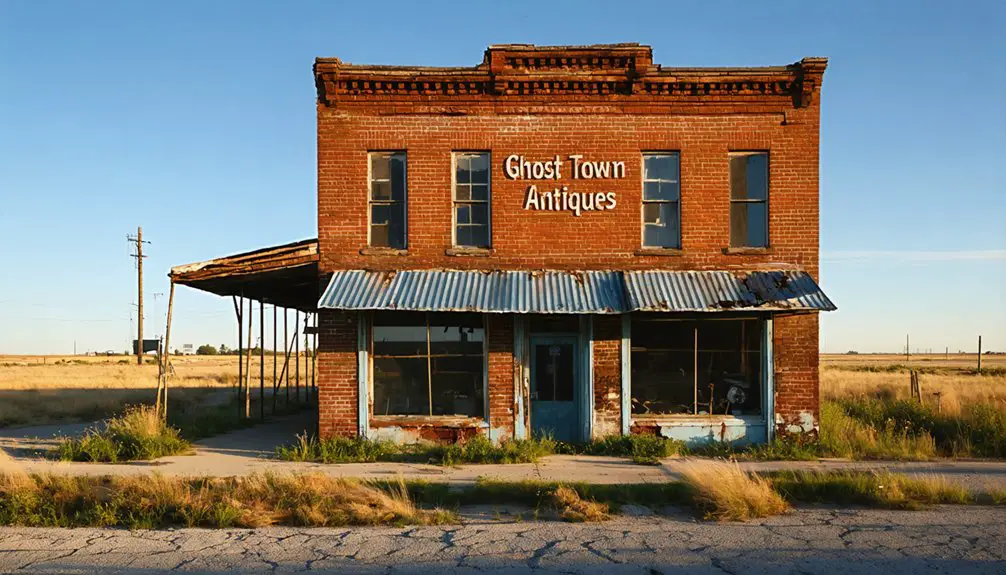You’ll find Hollister’s ghost town ruins in rural Oklahoma, where it thrived as an agricultural community from 1907 until the mid-1960s. The town’s iconic high school, built in 1922, served as its cultural center until closing in 1968. Today, abandoned structures and a vintage 1971 Ford Ranchero stand among the remnants, telling stories of bustling farms and local commerce. Hollister’s quiet streets hold fascinating tales of Oklahoma’s pioneering spirit and eventual decline.
Key Takeaways
- Hollister became a ghost town after its decline during the Great Depression, with the high school’s closure in 1968 marking its final transformation.
- The town retains architectural remnants including imposing high school columns and abandoned homes, with a 1971 Ford Ranchero among the ruins.
- Agricultural changes, resource depletion, and railroad bypass contributed to Hollister’s 80% population decline throughout the mid-20th century.
- Founded in 1907 as a rural farming community, Hollister thrived until economic hardships and population shifts led to its abandonment.
- Three generations of former residents preserve Hollister’s history through oral histories, photographs, and community storytelling events.
From Humble Beginnings to Empty Streets

When Hollister, Oklahoma emerged in 1907, few could’ve predicted its eventual fate as one of the state’s many ghost towns. You would’ve found a typical rural community taking shape, with families establishing homes and building their futures on Oklahoma soil. The Great Depression contributed heavily to the town’s decline, mirroring the economic devastation faced by countless Oklahoma communities.
Like numerous other settlements, Hollister fell victim to resource exhaustion and declining population. The town’s cultural heritage centered around its high school, constructed in 1922, which served as the heartbeat of community dynamics for nearly five decades.
You can still glimpse Hollister’s past through its remaining artifacts: the weathered high school entrance columns stand as silent sentinels, while an abandoned 1971 Ford Ranchero hints at the town’s final active years.
The Rise and Fall of a Rural Community
Through the early decades of the twentieth century, Hollister exemplified the classic pattern of rural Oklahoma development. You’d have found a bustling agricultural community, anchored by its local commerce and the establishment of a high school in 1922 that served as the heartbeat of community resilience.
But like many rural Oklahoma towns, Hollister couldn’t escape the powerful forces of change. When the railroads bypassed the town and urban migration drew younger generations away, the community’s foundation began to crack. Today, Hollister stands among an estimated two thousand ghost towns scattered across Oklahoma. Much like the town of Ringo, only a few abandoned buildings remain as silent witnesses to its past.
The school’s closure in 1968 marked a turning point – without this essential institution, the town’s social fabric unraveled quickly. The lack of economic diversification, combined with statewide “boom and bust” cycles, accelerated Hollister’s decline until it joined the ranks of Oklahoma’s ghost towns.
Educational Legacy and School Closure
Despite its essential role in sustaining rural life, Hollister’s educational system couldn’t withstand the sweeping changes of mid-20th century Oklahoma. The educational evolution reflected broader shifts in rural America, where mechanized farming and declining populations forced the consolidation of one-room schoolhouses into larger districts. Daily routines began with flag salute and prayer as students gathered to start their lessons. Similar to the transformation of the Naval Air Station in California, the old school grounds were repurposed for different community needs.
- Hollister High School closed in 1963 as population dwindled from its 1940 peak
- School memories of wood stoves and shared water kettles marked simpler times
- Teachers earned $18-25 monthly while boarding with local families
- Horse Creek School, like many others, found new life as a community center
- By 1968, all formal education within town limits had ceased
You’ll find echoes of this transformation across Tillman County, where over 100 rural schools merged into larger districts, forever changing the landscape of local education.
Agricultural Roots and Economic Changes
Agriculture’s central role in Hollister’s early development mirrors the broader settlement patterns you’ll find across Tillman County, where Native Americans and settlers cultivated cotton, corn, and wheat on modest family farms.
Early settlers faced significant hurdles as they had to adapt farming methods to succeed in the local conditions, learning through trial and error.
You’d have seen dramatic changes in local farming operations between 1930-2000, as average farm sizes expanded from 188 to over 800 acres through consolidation.
The shift toward mechanized farming and larger operations markedly reduced agricultural employment opportunities, contributing to Hollister’s declining population. The region’s agricultural evolution aligned with state patterns, where 86,000 farms now operate across Oklahoma.
Farming Shaped Early Growth
When settlers first discovered the fertile soil of Tillman County in the early 1900s, the area that would become Hollister changed from open pastureland for longhorn cattle into productive farmland.
The arrival of the Wichita Falls and Northwestern Railroad in 1909 established Hollister as a crucial agricultural hub, attracting farmers who’d benefit from the rich Southern Plains soil. The land’s transformation began after Congress passed the June 5, 1906 act that opened Big Pasture for settlement and farming.
- Winter wheat emerged as the region’s dominant crop
- Cotton gins and grain elevators quickly appeared near the railroad
- Early farming practices didn’t yet emphasize crop rotation
- Soil conservation wasn’t prioritized, leading to erosion
- The “Big Pasture” region shifted from grazing to farming
You’ll find that this agricultural foundation shaped Hollister’s early prosperity, though later environmental challenges would test the community’s resilience.
Mechanization’s Impact on Employment
The widespread adoption of tractors and mechanical harvesters in the early 20th century forever changed Hollister’s agricultural landscape.
As mechanization effects took hold, you’d have seen a dramatic shift from labor-intensive farming to machine-driven operations, requiring fewer but more skilled workers to run the equipment.
These employment shifts hit Hollister’s community hard.
Where once you’d find numerous farmhands tending the fields, now you’d see individual operators managing vast acreages with machinery.
Local farmers faced pressure to mechanize or sell out, while displaced workers had to seek opportunities elsewhere.
Young people, seeing limited prospects in agriculture, moved to urban areas for industrial jobs.
This transformation ultimately weakened Hollister’s economic foundation, leading to closed businesses, suspended schools, and a dwindling population that couldn’t sustain the town’s liveliness.
Like many ghost towns in Oklahoma, Hollister’s remaining structures and empty buildings stand as silent reminders of a once-thriving community.
Life Among the Remnants Today

Standing as a proof of Oklahoma’s rural decline, modern-day Hollister exists primarily through its architectural remnants, most notably the 1922 high school’s imposing columns and entrance that rise above a partially visible foundation.
When you visit today, you’ll find a stark landscape of community remnants that tell the story of a once-thriving town.
- Abandoned homes stand in various states of decay, though some structures remain surprisingly stable
- A vintage ’71 Ford Ranchero rests quietly among the ruins, preserved by the rural Oklahoma climate
- No permanent residents remain, though occasional visitors document the site’s historical significance
- The surrounding farmland has reclaimed much of the area, creating an eerily peaceful atmosphere
- You’ll need to come prepared, as there are no services or amenities available in this ghost town
Preserving the Memory of Hollister
You’ll find Hollister’s story preserved through meticulous historical documentation by scholars like John W. Morris and Jeffrey B. Schmidt, whose research draws from over 1,200 primary sources housed at the University of Oklahoma.
Local voices and personal accounts from former residents bring the ghost town’s past to life through oral histories archived in the Western History Collection.
Through a combination of academic scholarship and community storytelling, you’re able to experience how this once-thriving Oklahoma town transformed into the quiet remnants visible today.
Historical Documentation Methods
When exploring Oklahoma’s ghost towns, researchers employ multiple documentation methods to preserve Hollister’s history for future generations. Through extensive archival research at the University of Oklahoma’s Western History Collection and recorded oral histories from former residents, you’ll find over 1,200 primary and secondary sources that tell Hollister’s story.
- Scholarly publications by University of Oklahoma Press document the town’s founding in 1907 and subsequent decline.
- On-site surveys capture remaining structures, including Hollister High School’s columns.
- Video and photographic evidence preserve visual records of the town’s layout and decay.
- Government records and census data track the town’s 80% population decline.
- Digital databases and multimedia platforms guarantee broad access to Hollister’s history for researchers and enthusiasts.
Storytelling Through Local Voices
Three generations of Hollister residents have kept their town’s memory alive through vivid storytelling and shared experiences.
You’ll find these local narratives preserved through oral histories, family photographs, and treasured memorabilia that paint a picture of daily life from the town’s 1907 founding through its eventual decline.
Community storytelling events and reunions serve as essential gatherings where tales of the old high school, built in 1922, and memories of bustling local businesses continue to echo.
Through these accounts, you’ll discover how the school’s remaining columns stand as silent witnesses to Hollister’s vibrant past.
While official records tell one story, it’s the firsthand accounts of residents and their descendants that truly bring the ghost town’s history to life, transforming abandoned structures into landmarks of lived experiences.
Frequently Asked Questions
Are There Any Paranormal Activities Reported in Hollister’s Abandoned Buildings?
You’ll find numerous ghost sightings throughout Hollister’s abandoned structures, especially in the old gymnasium-turned-morgue, where witnesses report apparitions, unexplained noises, shadowy figures, temperature drops, and electromagnetic disturbances.
What Happened to the Original Town Records and Documents?
Like scattered seeds in the wind, you’ll find most original records vanished when the town died. Missing archives weren’t preserved, though you might discover fragments in county offices or state historical collections.
Did Any Famous People or Notable Events Originate From Hollister?
You won’t find any famous residents or notable events from Hollister’s history – there’s no documented evidence of nationally significant figures or happenings emerging from this small Oklahoma farming community.
Can Visitors Legally Explore and Photograph the Remaining Structures Today?
You’ll need to obtain landowner permission before exploring the structures, as they’re likely on private property. While roadside photography is generally acceptable, entering without explicit approval risks trespassing violations.
Were There Any Major Crimes or Tragedies That Contributed to Hollister’s Decline?
Prudently put, you won’t find crime statistics or historical tragedies driving the decline. Unlike some notorious ghost towns, Hollister’s story reflects routine economic shifts, railroad changes, and population trends typical of rural Oklahoma.
References
- https://www.youtube.com/watch?v=_Dx4Y-Php4M
- https://en.wikipedia.org/wiki/List_of_ghost_towns_in_Oklahoma
- https://www.okhistory.org/publications/enc/entry?entry=GH002
- https://okmag.com/blog/a-ghostly-site/
- https://kids.kiddle.co/List_of_ghost_towns_in_Oklahoma
- http://sites.rootsweb.com/~oktttp/ghost_towns/ghost_towns.htm
- https://www.wikiwand.com/en/articles/List_of_ghost_towns_in_Oklahoma
- http://tillmancountychronicles.blogspot.com/2011/02/
- https://en.wikipedia.org/wiki/Hollister
- https://www.okhistory.org/shpo/docs/ruralschoolsswok.pdf



